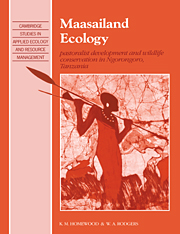Book contents
- Frontmatter
- Contents
- Preface
- 1 Management problems and applied ecology in Ngorongoro Conservation Area
- 2 Ngorongoro Conservation Area
- 3 Maasai of Ngorongoro
- 4 History, politics and perceptions in Ngorongoro
- 5 Management-oriented research in NCA
- 6 Range resources
- 7 Wildlife
- 8 Livestock ecology
- 9 Livestock and wildlife
- 10 Maasai ecology: development, demography and subsistence
- 11 Wildlife conservation and pastoralist development
- 12 Development interventions
- 13 Viewpoint
- References
- Author index
- Subject index
- Map: Ngorongoro Conservation Area, showing the main features and place names used in the text
3 - Maasai of Ngorongoro
Published online by Cambridge University Press: 08 February 2010
- Frontmatter
- Contents
- Preface
- 1 Management problems and applied ecology in Ngorongoro Conservation Area
- 2 Ngorongoro Conservation Area
- 3 Maasai of Ngorongoro
- 4 History, politics and perceptions in Ngorongoro
- 5 Management-oriented research in NCA
- 6 Range resources
- 7 Wildlife
- 8 Livestock ecology
- 9 Livestock and wildlife
- 10 Maasai ecology: development, demography and subsistence
- 11 Wildlife conservation and pastoralist development
- 12 Development interventions
- 13 Viewpoint
- References
- Author index
- Subject index
- Map: Ngorongoro Conservation Area, showing the main features and place names used in the text
Summary
Iltung'ana loo ngishu The people of cattle.
(Maasai describing Maasai: Galaty 1982)The Maasai, their herds and the ecological implications of their land use are central to the theme of this book. While much of our research concentrated on plant and animal communities, it is the interactions of these plant and animal systems with people that are at issue. The key to understanding Ngorongoro is the fact that pastoralists and their herds have been part of the ecosystem for millennia. The ecology of the area is bound up with the Maasai and their land use.
This chapter sets out to give some idea of what it is like to be a Maasai pastoralist in Ngorongoro. Starting with a description of Maasai settlements in NCA, and of the pattern of daily life there, we follow the Maasai herds through the changing seasons in a year's cycle. This material is mainly drawn from our own observations gathered while living in or near Maasai settlements in NCA. We explain the structure and function of the settlements and set out the social systems of section, clan, and age-set. These are fundamental to the way Maasai society deals with the opportunities and constraints presented by their environment, and as such have inescapable implications for the issues of population, subsistence and development covered in later chapters.
This chapter goes on to explore the prehistoric origins of pastoralists in East Africa and of the Maasai in Ngorongoro.
- Type
- Chapter
- Information
- Maasailand EcologyPastoralist Development and Wildlife Conservation in Ngorongoro, Tanzania, pp. 35 - 68Publisher: Cambridge University PressPrint publication year: 1991
- 1
- Cited by



